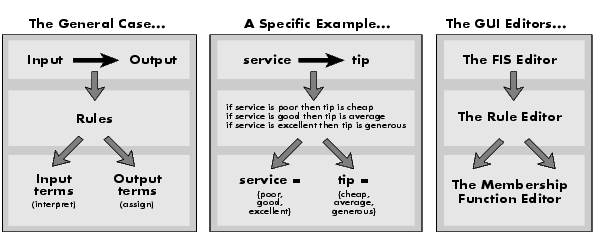

| Fuzzy Logic Toolbox |   |
Building Systems with the Fuzzy Logic Toolbox
Dinner for Two, from the Top
Now we're going to work through a similar tipping example, only we'll be building it using the graphical user interface (GUI) tools provided by the Fuzzy Logic Toolbox. Although it's possible to use the Fuzzy Logic Toolbox by working strictly from the command line, in general it's much easier to build a system graphically. There are five primary GUI tools for building, editing, and observing fuzzy inference systems in the Fuzzy Logic Toolbox: the Fuzzy Inference System or FIS Editor, the Membership Function Editor, the Rule Editor, the Rule Viewer, and the . These GUIs are dynamically linked, in that changes you make to the FIS using one of them, can affect what you see on any of the other open GUIs. You can have any or all of them open for any given system.
In addition to these five primary GUIs, the toolbox includes the graphical ANFIS Editor GUI, which is used for building and analyzing Sugeno-type adaptive neural fuzzy inference systems. The ANFIS Editor GUI is discussed later in the section, Sugeno-Type Fuzzy Inference.
The FIS Editor handles the high-level issues for the system: How many input and output variables? What are their names? The Fuzzy Logic Toolbox doesn't limit the number of inputs. However, the number of inputs may be limited by the available memory of your machine. If the number of inputs is too large, or the number of membership functions is too big, then it may also be difficult to analyze the FIS using the other GUI tools.
The Membership Function Editor is used to define the shapes of all the membership functions associated with each variable.
The Rule Editor is for editing the list of rules that defines the behavior of the system.
The Rule Viewer and the Surface Viewer are used for looking at, as opposed to editing, the FIS. They are strictly read-only tools. The Rule Viewer is a MATLAB based display of the fuzzy inference diagram shown at the end of the last section. Used as a diagnostic, it can show (for example) which rules are active, or how individual membership function shapes are influencing the results. The Surface Viewer is used to display the dependency of one of the outputs on any one or two of the inputs--that is, it generates and plots an output surface map for the system.
This section began with an illustration similar to the one below describing the main parts of a fuzzy inference system, only the one below shows how the three Editors fit together. The two Viewers examine the behavior of the entire system.

The five primary GUIs can all interact and exchange information. Any one of them can read and write both to the workspace and to the disk (the read-only viewers can still exchange plots with the workspace and/or the disk). For any fuzzy inference system, any or all of these five GUIs may be open. If more than one of these editors is open for a single system, the various GUI windows are aware of the existence of the others, and will, if necessary, update related windows. Thus if the names of the membership functions are changed using the Membership Function Editor, those changes are reflected in the rules shown in the Rule Editor. The editors for any number of different FIS systems may be open simultaneously. The FIS Editor, the Membership Function Editor, and the Rule Editor can all read and modify the FIS data, but the Rule Viewer and the Surface Viewer do not modify the FIS data in any way.
 | Customization | Getting Started |  |